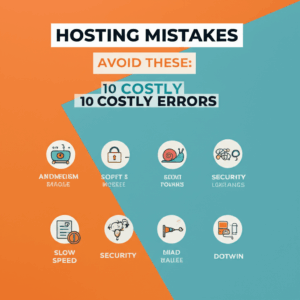- Common Hosting Mistakes That Can Cost You
- Neglecting Website Security
- Ignoring Website Backups
- More Hosting Mistakes to Steer Clear Of
- Not Optimizing Your Website for Performance
- Failing to Monitor Website Performance
- Avoiding Advanced Hosting Mistakes
- Not Utilizing a Content Delivery Network (CDN)
- Failing to Plan for Traffic Spikes
- Ignoring the Importance of Server Location
Hosting Mistakes: Avoid These 10 Costly Errors
Hosting mistakes can cripple your website’s performance, damage your search engine rankings, and even lead to security breaches. Choosing the right web hosting is crucial for your online success, but even with the perfect host, common errors can undermine your efforts. Avoiding these pitfalls is essential for maintaining a healthy, efficient, and secure online presence. This article will outline ten common hosting mistakes and provide practical advice on how to avoid them.
Common Hosting Mistakes That Can Cost You

One of the most frequent hosting mistakes is choosing the wrong hosting plan. From shared hosting to dedicated servers, the options are numerous. Opting for the cheapest shared hosting plan might seem appealing initially, especially for new websites. However, as your site grows, this can lead to performance issues. Shared hosting means sharing server resources with numerous other websites. This can result in slow loading times and downtime during traffic spikes, ultimately affecting user experience and potentially driving visitors away. Assess your website’s needs carefully. Consider factors like anticipated traffic, storage requirements, and the need for specific software or functionalities.
Neglecting Website Security
Another critical error is neglecting website security. Failing to implement robust security measures can leave your website vulnerable to malware, hacking attempts, and data breaches. This can not only compromise sensitive information but also damage your reputation and erode user trust. Regularly updating your website’s software, installing security plugins, and implementing strong passwords are essential steps in mitigating security risks. Consider using a Web Application Firewall (WAF) and implementing two-factor authentication for added protection.
Ignoring Website Backups
Overlooking regular website backups is a recipe for disaster. Hardware failures, software glitches, or even accidental deletions can lead to significant data loss. Without regular backups, recovering your website can be a time-consuming and costly process, or even impossible. Implement automated backups and ensure they are stored securely, preferably offsite. Regularly test your backups to ensure they are functioning correctly and can be restored effectively.
More Hosting Mistakes to Steer Clear Of
Choosing a host with poor customer support can be a major headache. When issues arise, you need reliable and responsive support to help you troubleshoot problems quickly and efficiently. Before committing to a hosting provider, research their customer support options. Look for 24/7 availability through multiple channels, such as phone, email, and live chat.
Not Optimizing Your Website for Performance
Even with a robust hosting plan, failing to optimize your website for performance can lead to slow loading times and a poor user experience. Large image files, unoptimized code, and excessive HTTP requests can all contribute to sluggish performance. Optimize images, leverage browser caching, and minify CSS and JavaScript files to improve your website’s speed and efficiency.
Failing to Monitor Website Performance
Ignoring website performance metrics is like driving blind. Without regular monitoring, you won’t be aware of potential issues until they become significant problems. Utilize website monitoring tools to track uptime, loading times, and resource usage. This allows you to identify and address performance bottlenecks proactively.
Avoiding Advanced Hosting Mistakes
Overlooking scalability is another significant hosting mistake. As your website grows, your hosting needs will evolve. Choosing a hosting plan that doesn’t offer scalability can limit your growth potential. Consider cloud hosting or VPS solutions that allow you to easily scale resources up or down as needed.
Not Utilizing a Content Delivery Network (CDN)
If your website targets a global audience, not using a CDN can lead to slow loading times for users in different geographical locations. A CDN stores cached copies of your website’s content on servers distributed around the world, ensuring faster delivery to users regardless of their location.
Failing to Plan for Traffic Spikes
Sudden surges in traffic, perhaps due to a marketing campaign or viral content, can overwhelm your server and lead to downtime. Failing to plan for these traffic spikes can significantly impact your website’s availability and user experience. Consider using a scalable hosting solution and load testing your website to ensure it can handle traffic fluctuations.
Ignoring the Importance of Server Location
The physical location of your server can impact your website’s loading speed, especially for users located far from the server. Choose a server location that is geographically close to your target audience to minimize latency and improve performance.
By avoiding these ten hosting mistakes, you can ensure your website runs smoothly, efficiently, and securely, providing a positive experience for your visitors and maximizing your chances of online success. Take the time to research your options, plan for growth, and prioritize website security and performance. Your website, and your users, will thank you for it.











Leave a Reply